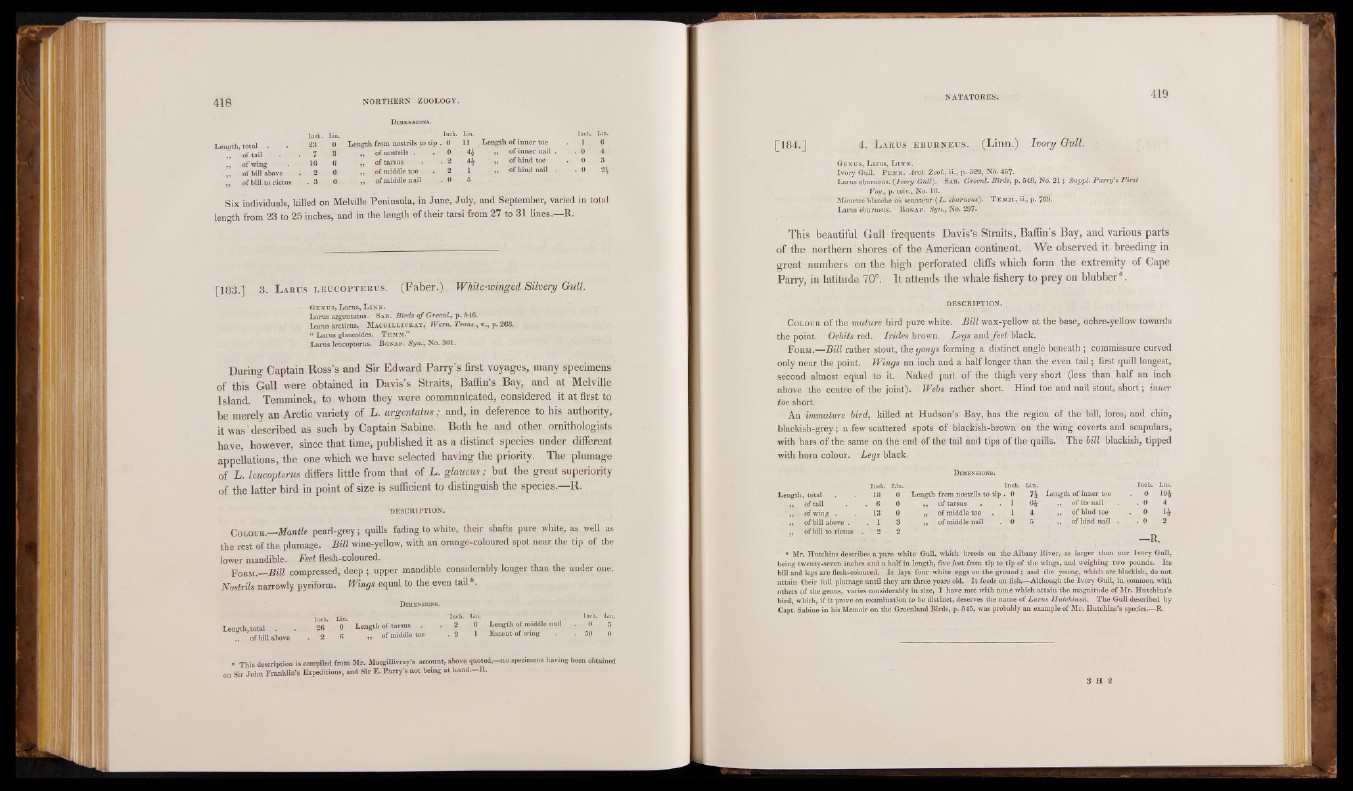
Length,total,, . 23 0
„ of tail • 7 3
,, of wing . 16 6
_M of bill above 2 0
„ of bill , to rictus . 3 0
Dimensions.
Inch. Lin.
Length from nostrils to tip .. 0 11
,, of nostrils . 0 4*
,, of tarsus . 2 44
,, of middle toe 2 I
„ of middle nail . 0 5
Length of inner toe 1 6 „ of-inner nail . ; . 0 4
,, pf hind toe 0 3
,, of hind nail. . . 0 24
Six individuals, killed on Melville Peninsula, in June, July, and September, varied in total
length from 23 to 25 inches, and in the length of their tarsi from 27 to 31 lines.—R.
[183.] 3. L a r u s l e u c o p t e r u s . (Faber.)..’ White-winged Silvery Gull.
-— Ge n u s , Larus, L in n .
Larus argentatus. Sab. Birds of Greenl., p. 546.
Larus arcticus. M a c g il l iv r a y , Wem. Trans., v., p. 268.
“ Larus glaucoides. Temm.”
Larus leucopterus. B onap. Syn., No. 301.
During Captain Ross’s and Sir Edward Parry’s first voyages, many specimens
of this Gull were obtained in Davis’s Straits, Baffin’s Bay, and at Melville
Island. Temminck, to whom they were communicated, considered it at first to
be merely an Arctic variety of L. argentatus; and, in deference to his authority,
it was'described as such by Captain Sabine. Both he and other ornithologists
have, however, since that time, published it as a distinct species under different
appellations, the one which we have selected having the priority. The plumage
of L. leucopterus differs little from that of L. glaucus; but the great superiority
of the latter bird in point of size is sufficient to distinguish the species.—R.
DESCRIPTION.
Co l o u r ._Mantle pearl-grey; quills fading to white, their shafts pure white, as well as
the rest of the plumage. Bill wine-yellow, with an orange-coloured spot near the tip of the
lower mandible. F Feet flesh-coloured. orm.—Bill compressed, deep ; upper mandible considerably longer than the under one.
Nostrils narrowly pyriform. Wings equal to the even tail*.
Length, total . • 26
„ of hill above • '2
Dimensions.
Lin. ! Inch. Lin.
0 Length of tarsus . . 2 6
6 .,r of middle toe . 2 1
Inch. Lin.
Length of middle nail . 0 5
Extent of wing . . 50 0
• This description is compiled from Mr. Macgfflivray’s account, above quoted,—no specimens having been obtained
on Sir John Franklin’s Expeditions, and Sir E. Parry’s not being at hand.—R.
[184.] 4. L a r u s e b u r n e u s . (Linn.) Ivory Q uit
Ge n u s, Larus, L in n .
Ivory Gull. P e n n . Arct. Zöol., ii., p. 529, No. 457.
Larus eburneus. (Ivory Gult). Sab. Greenl. Birds, p. 548, No. 21 ; Suppl. Parry's First
Voy., p. cciv., No. 18.
Mouette hlahché où sénateur (L. eburneus). T emm., ii., p. 769.
Larus eburneus. Bonap. Syn., No. 297*
This beautiful Gull frequents Davis’s Straits, Baffin’s Bay, and various parts
of the northern shores of the American continent. We observed it breeding in
great numbers on the high perforated cliffs which form the extremity of Cape
Parry, in latitude 70°. It attends the whale fishery to prey on blubber*.
DESCRIPTION.
Colour of the mature bird pure white. Bill wax-yellow at the base, ochre-yellow towards
the point. Orbits red. Irides brown. Legs and feet black.
Form.—Bill rather stout, the gonys forming a distinct angle beneath ; commissure curved
only near the point. Wings an inch and a half longer than the even tail; first quill longest,
second almost equal to it. Naked part of the thigh very short (less than half an inch
above the centre of the joint). Webs rather short. Hind toe and nail stout, short; inner
toe short.
An immature bird, killed at Hudson’s Bay, has the region of the bill, lores, and chin,
blackish-grey; a few scattered spots of blackish-brown on the wing coverts and scapulars,
with bars of the same on the end of the tail and tips of the quills. The bill blackish, tipped
with horn colour. Legs black.
Dimensions.
Length, total 18 0 Length from nostrils to tip . 0
Lin.
74 Length of inner toe
Inch. Lin.
o 104
„ of tail „ of tarsus . 1 64 „ of its nail . 0 4
„ , of wing . 13 6 0 0 „ of middle toe . 1 4 . „ of hind toe 0 14
„ of bill above . 1 3 ,, of middle nail 0 5 : „ of hind nail . . 0 2
„ of bill to rictus .
2 2
• * Mr. Hutchins describes
a pure white' Gull, which breeds on the Albany River, iis larger than our
— R .
Ivory Gull,
being twenty-seven inches and a half in length, five feet from tip to tip of the wings, and weighing two pounds. Its
bill and legs are flesh-coloured. It lays four white eggs on the ground; and the young, which are blackish, do not
attain their full plumage until they are three years old. It feeds on fish.—Although the Ivory Gull, in common with
others of the genus, varies considerably in size, I have met with none which attain the magnitude of Mr. Hutchins’s
bird, which, if it prove on examination to be distinct, deserves the name of Larus Hutchinsii. The Gull described by
Capt. Sabine in his Memoir on the Greenland Birds, p. 545, was probably an example of Mr. Hutchins’s spedes.—R.